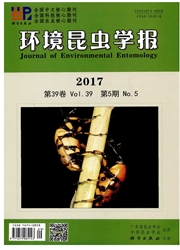

 中文摘要:
中文摘要:
建立适用于小菜蛾蛋白质组学研究的样品前处理方法。应用SDS-PAGE电泳比较分析了TCA-丙酮沉淀,Tris-饱和酚抽提,RIPA Lysis Buffer和I-PER Reagent直接裂解4种方法对小菜蛾幼虫总蛋白的抽提质量。结果显示:4种方法对小菜蛾全蛋白的提取率差异比较显著,其中RIPA Lysis Buffer和I-PER Reagent两种直接裂解法蛋白提取率最高,分别为52.06 mg/g和46.16 mg/g;TCA-丙酮沉淀法提取率适中,为34.58 mg/g;Tris-饱和酚抽提法提取率最低,为27.39 mg/g。SDS-PAGE电泳分析表明,Tris-饱和酚抽提法蛋白谱条带分辨率最高,蛋白条带最多,为32条,在17.0 k Da-245 k Da的范围内分布均匀;TCA-丙酮沉淀法蛋白谱带数目为30条,条带清晰,分辨率较高,但缺失部分蛋白;RIPA Lysis Buffer和I-PER Reagent两种直接裂解法蛋白谱条带数目较少,小分子蛋白条带丢失或不明显。根据蛋白提取率和条带的数量综合分析,TCA-丙酮沉淀法适用于小菜蛾蛋白质组学的样品前处理。
 英文摘要:
英文摘要:
To establish a suitable sample preparation method for proteomic studies of the diamondback moth, Plutella xylostella (L.). The total protein extraction quality of the diamondback mothlarva by trichloroaceticacid (TCA) /acetoneprecipitation, Tris -saturated phenol, RIPA Lysis Buffer and I - PER Reagent direct decomposition methods were compared and analyzed by SDS - PAGE electrophoresis. The results showed that, extraction rate of four protein preparation methods were significantly different instatistical analysis. Two of RIPA Lysis Buffer and I - PER Reagent direct decomposition methods presented the highest yield were 52.06 mg/g and 46. 16 mg/g, respectively, followed by trichloroacetic acid (TCA) /acetone precipitation method, with a number of 34. 58 mg/g. The yield of Tris - saturated phenol extraction method was the lowest, with number of 27.39 mg/g. The analyzed result by SDS - PAGE electrophoresis indicated that, Tris -saturated phenol extraction method produced the highest number of 32 bands with best resolution, equally distributed from 17.0 kDa -245 kDa. The trichloroacetic acid (TCA) /acetone precipitation method had 30 clear and high resolution protein bands, but a number of bands were lost. Two of RIPA Lysis Buffer and I - PER Reagent direct decomposition methods showed the lowest number of bands, some small molecular weight protein bands were lost or became unapparent. Comprehensive analysis of these results showed that the trichloroacetic acid (TCA) /acetone precipitation was the most appropriate sample preparation method for the diamondback moth proteomics.
 同期刊论文项目
同期刊论文项目
 同项目期刊论文
同项目期刊论文
 期刊信息
期刊信息
